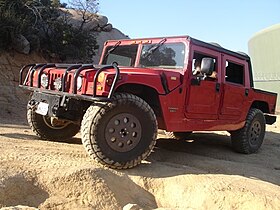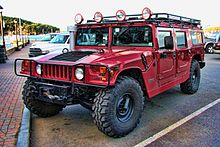Hummer H1
This article needs additional citations for verification. (March 2015) |
| Hummer H1 | |
|---|---|
 | |
| Overview | |
| Manufacturer | AM General |
| Also called | Hummer HMC (1992–2002) |
| Production | 1992–2006 |
| Model years | 1992–2004, 2006 |
| Assembly | Mishawaka, Indiana, United States Kaliningrad, Russia (Avtotor, 2004-2010) Port Elizabeth, South Africa |
| Body and chassis | |
| Class | Large truck/SUV |
| Body style | 4-door pickup truck 2-door pickup truck 4-door wagon 4-door convertible - based on Humvee |
| Layout | Front-mid engine, four-wheel drive |
| Related | Humvee AM General military vehicle |
| Powertrain | |
| Engine | 6.2 L Detroit Diesel V8 6.5 L Detroit Diesel V8 5.7 L Vortec V8 6.5 L turbo Detroit Diesel V8 6.6 L turbo DMAX Diesel V8 |
| Transmission | GM TH400/3L80 3-speed automatic GM 4L80-E 4-speed automatic Allison 1000 5-speed automatic< |
| Dimensions | |
| Wheelbase | 130 in (3,302 mm) |
| Length | 184.5 in (4,686 mm) |
| Width | 86.5 in (2,197 mm) |
| Height | 77 in (1,956 mm) 2004–06: 79 in (2,007 mm) Pre-2003 Wagon: 75 in (1,905 mm) |
| Chronology | |
| Successor | Hummer H2 |
The Hummer H1 is a civilian off-road vehicle based on the M998 Humvee, which was created by AM General. The vehicle was produced from 1992 through 2006, and was the first of what became the Hummer line. It was initially known only as the "Hummer"; however, in 1999 in a joint venture between General Motors and AM General, GM began marketing the Hummer H2, which was built on a heavily modified GMC 2500HD chassis. It was at this point that the original Hummer was given the H1 designation. For collectors, the most desirable model is the H1 Alpha, produced in the final model year of 2006. It had the most powerful engine and the best fuel mileage of the H1 vehicles. Overall, the H1 was a very limited production vehicle.
"Originally designed strictly for military use the four-wheel-drive utility vehicle was released to the civilian market due to popular demand. Boasting 16 inches (40 cm) of ground clearance as well as super-aggressive approach and departure angles, the Hummer H1 could clamber over a 22-inch (56 cm) high obstacle, handle a 60 percent grade and wade through up to 30 inches (76 cm) of water."[1]
History
Originally released in the civilian market March 14, 1992, the Hummer H1 owed its birth to the popularity of photos from Operation Desert Storm and the enthusiastic campaign from actor-politician Arnold Schwarzenegger, who owns several variants of Hummer vehicles. AM General announced that 2006 would be the last model year for the Hummer H1, with production winding down in June 2006 due to a new emission law for diesel engine vehicles, which took effect in 2007.
Specifications
The Hummer H1 has three common variants: a convertible-like soft top, a four-door hard top Sport Utility Truck and an Alpha Wagon body version. Other less known variants include a two-door pickup truck, most commonly seen in the military sporting Anti-Air weapon turrets and other launchers, or used as troop and cargo transports, and a four-door slantback, which shares the same body style of the Humvee employed by the U.S. Military. The convertible/soft top and the station wagon versions were the last ones available in the mass market. The two-door and four-door pickup versions are only available in fleet livery.
Currently, five engine types and three automatic transmission types can be found in Hummer H1s. The common engine/automatic transmission combinations are:
- 6.2 L GM Diesel V8/GM TH400/3L80 3-speed
- 6.5 L GM Diesel V8/GM 4L80-E 4-speed
- 5.7 L Vortec 5700 gasoline V8 TBI/GM 4L80-E 4-speed
- 6.5 L turbo GM Diesel V8/GM 4L80-E 4-speed
- 6.6 L turbo Duramax LLY V8 turbo Diesel/Allison 1000 5-speed (model year 2006)
The Hummer H1 shares some common driveline parts with its HMMWV brethren. Items like brakes, axles, frame and major body panels (hood, tailgate and quarter panels) are shared between the HMMWV and Hummer H1. All H1s and HMMWVs were produced on the same assembly line; of which civilian H1s were then painted and finished in a separate building opposite the parking lot.
Hummer H1s are unique in the way they handle off road [citation needed], and in their interior arrangement. Passenger and highway comfort are sacrificed for maximum mobility compared to civilian SUVs, with features much more radical than the original Jeep[citation needed], though they do share a similarly cut simple grille opening. They are inherently very stable, thanks to their wide track. They can ford 30 inches (76 cm) of water and climb a 22-inch (56 cm) step. Their stock ground clearance of 16 inches (41 cm) is made possible by tucking driveline components inside a channel in the central space between the left and right seats. They have high approach/departure angles of 72/37.5 degrees. Most H1s are equipped with a Central Tire Inflation System (CTIS), which enables the driver to increase or decrease the tire air pressure at the push of a button, since lower tire pressures are more suited for off road, and higher tire pressures are desirable on-road.
Hummer H1s have many unusual features, such as inboard brakes and portal gears which allow the drivetrain's half shafts a higher placement, for greater ground clearance. The radiator is up high, sloping over the engine on a forward-hinged hood. The air intake is high-mount, enabling the H1 to ford waist-level water. Rather than using simple runflat tires, magnesium-aluminum alloy or rubber inserts are an optional feature for runflat ability. A chemical agent resistant coating, or CARC, is available only on the military version.
2006 Hummer H1 Alpha

The "Alpha" was an extensively re-engineered H1 that was equipped with GM's Duramax Diesel and 5-speed Allison transmission. The previous version of the H1 with the 6.5L "Optimizer" turbo-diesel engine suffered from sluggish sales; lack of power was one of the reasons for customer resistance. In 2002, AM General CEO Jim Armour took the idea of repowering the H1 to Bob Lutz and the GM Luxury Vehicle committee. GM soon approved the use of their Duramax/Allison powertrain for the H1. This would support the continuation of the H1 as the grandparent of the Hummer portfolio; it would also allow AM General to give the truck a much needed dose of updating in terms of power, torque, refinement and the ability to meet 2004 heavy duty EPA emissions requirements.
The update program commenced in late 2002 with production launch slated to be fall of 2004. The engineering team chose the engine variant out of the GMT560 truck (the C4500) because it packaged better into the H1 engine bay; however, 23 engine component changes were required and the team had to do a 2.0 in (51 mm) body lift to accommodate the taller engine and its turbo housing (a prior 0.5 in (13 mm) lift had been done for MY96 to accommodate the turbo on the 6.5L engine). The GMT560 engine calibration was used with minimal modification; engine output was 300 hp (220 kW) and 520 lb⋅ft (705 N⋅m) of torque. Due to the Duramax engine being equipped with cooled exhaust gas recirculation and an internal engine oil cooler, the team had to deal with a 40 percent heat rejection increase to engine coolant. However, they were unable to increase the size of the cooling pack between the air-lift brackets that protrude from the hood. This meant dramatically re-engineering the fan system by putting the fan directly under the coolpack and driving it through a special gearbox directly off the crankshaft damper pulley. Several other cooling system modifications were required to assist with cold starting from −30 °F (−34 °C).
Other major modifications included the use of special high-strength steel in the chassis frame, a more powerful steering gear; quieter axle differentials, redesign of the geared hubs to use quieter helical gears, new induction, exhaust and electrical power systems; and re-engineering of the fuel supply and filtration system.
Off road the much higher torque of the engine, combined with a lower gearing ratio (about 44.5 to 1 in low lock), made the truck much more powerful. The Duramax engine delivered more torque at lower engine speeds than the 6.5L, so the team actually had to calibrate the torque management to protect certain driveline parts. This new torque profile coupled with centralized tire inflation and AM General's new interior resulted in the complete re-engineering of everything except the carryover body made of aluminum beams and panels.
Production launch was early in 2005, and continued until production ceased in mid-2006. All vehicles built during this time are classified as model year 2006 (10th digit in VIN is a 6.)
The program was cancelled May 12, 2006 because GM decided to withdraw technical and financial support for future engineering and recertification.
Price

In the original 1992 production run, the price of the basic open-top was $40,500 while a fully loaded wagon with all options was $54,700.
In 2006, the suggested retail price was $129,399.00 for the open-top; the wagon was $140,796.00, H1 Alpha was priced at $150,975.00.
The Hummer brand
On June 2, 2009, General Motors attempted a sale of its Hummer brand to a Chinese company, Tengzhong, as part of its bankruptcy settlement. GM stated at the time that it hoped the sale would save about 3,000 jobs in the US.
On February 24, 2010, General Motors announced that the company was shutting down its Hummer brand due to Tengzhong withdrawing its bid. Tengzhong stated that the bid was withdrawn due to a failure to get approval from the Chinese government.[2]
Yearly sales
| Calendar Year | Total sales |
|---|---|
| 1992 | 316 |
| 1993 | 612 |
| 1994 | 718 |
| 1995 | 1,432 |
| 1996 | 1,374 |
| 1997 | 1,209 |
| 1998 | 945 |
| 1999 | 831 |
| 2000 | 1,333 |
| 2001 | 869 |
| 2002 | 704 |
| 2003 | 494 |
| 2004 | 252 |
| 2005 | 0 |
| 2006 | 729 |
| Total | 11,818 |
Gallery
- Hummer H1 models showing differences, similarities, and other styles
-
2004 Hummer undercarriage.
-
A modified, red Hummer H1 in a parking lot.
-
A camouflaged Humvee military version of hummer in San Francisco, showing the grill, hood, windshield, and headlights detail.
-
A Hummer H1 Sport Utility Truck, showing its durability and power when driving through mud and water.
See also
- Humvee
- Hummer
- General Motors
- GAZ Tiger
- FMC XR311
- Toyota Mega Cruiser
- Land Rover Defender
- Iveco LMV
- Tiuna
- Lamborghini LM002
- Hummer H2
References
- ^ "Hummer H1 Review". Edmunds.com. Retrieved 2009-09-27.
- ^ G.M. to Close Hummer After Sale Fails
External links
- Hummer
- AM General
- Hummer H1 Maintenance Manuals Hummer H1 Maintenance Manuals and Parts






